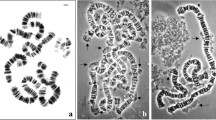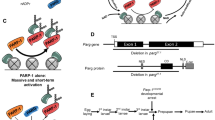Abstract
GIANT polytene chromosomes from the salivary glands of various fly larvae have been extensively examined; because of their enormous size they have become one of the most important tools in investigations of gene activity and nuclear-cytoplasmic relationships. Malpighian tubules and certain other tissues of flies also possess polytene chromosomes, but they show a lower degree of polyteny. It is generally accepted that in most animal and plant cells there is a constant relation between the DNA content and the number of chromosome ‘sets’ it contains. Synthesis of DNA results in a doubling of this pre-existing amount; a dipteran polytene chromosome may result from more than a thousand such replications1. Recently it has been suggested2 that differentiation in a multicellular organism involves the progressive inactivation of DNA, and that, in the polytene chromosome, three conditions characterize these inactivated regions: first, inactivity with respect to RNA synthesis; secondly, late replication, replication being slower and continuing longer than over the rest of the chromosome; thirdly, the appearance of dense packing. Heavy bands and heterochromatic regions are given as typical examples of such regions.
This is a preview of subscription content, access via your institution
Access options
Subscribe to this journal
Receive 51 print issues and online access
$199.00 per year
only $3.90 per issue
Buy this article
- Purchase on Springer Link
- Instant access to full article PDF
Prices may be subject to local taxes which are calculated during checkout
Similar content being viewed by others
References
Swift, H., in The Molecular Control of Cellular Activity, 73 (McGraw-Hill, New York, 1962).
Fujita, S., Nature, 206, 742 (1965).
Whitten, J. M., Proc. Sixteenth Intern. Zool. Congress, Washington, 276 (1963).
Whitten, J. M., Science, 143, 1437 (1964).
Breuer, M. E., and Pavan, C., Chromosoma, 7, 371 (1955).
Stich, H. F., and Naylor, J. M., Exp. Cell. Res., 14, 442 (1958).
Kimoto, Y., Cytologia, 23, 478 (1958).
Kaufman, B. P., and Gay, H., The Nucleus, 1, 57 (1958).
Gay, H., Cold Spring Harb. Symp. Quant. Biol., 21, 257 (1956).
Bayreuther, K., Chromosoma, 7, 508 (1956).
Author information
Authors and Affiliations
Rights and permissions
About this article
Cite this article
WHITTEN, J. Differential Deoxyribonucleic Acid Replication in the Giant Foot-pad Cells of Sarcophaga bullata. Nature 208, 1019–1021 (1965). https://doi.org/10.1038/2081019a0
Issue Date:
DOI: https://doi.org/10.1038/2081019a0
This article is cited by
-
Characterization of Parasarcophaga heterochromatin
Chromosoma (1989)
-
Determination of DNA content in the nurse and follicle cells from wild type and mutant Drosophila melanogaster by DNA-Feulgen cytophotometry
Histochemistry (1985)
-
Genomic organization in the flesh fly Sarcophaga bullata
Chromosoma (1979)
-
Characterization of extrachromosomal DNA in the flesh fly Sarcophaga bullata
Chromosoma (1979)
-
Patterns of incorporation of tritiated thymidine by the dorsal polytene foot-pad nuclei of Sarcophaga bullata (Sarcophagidae: Diptera)
Chromosoma (1976)
Comments
By submitting a comment you agree to abide by our Terms and Community Guidelines. If you find something abusive or that does not comply with our terms or guidelines please flag it as inappropriate.



